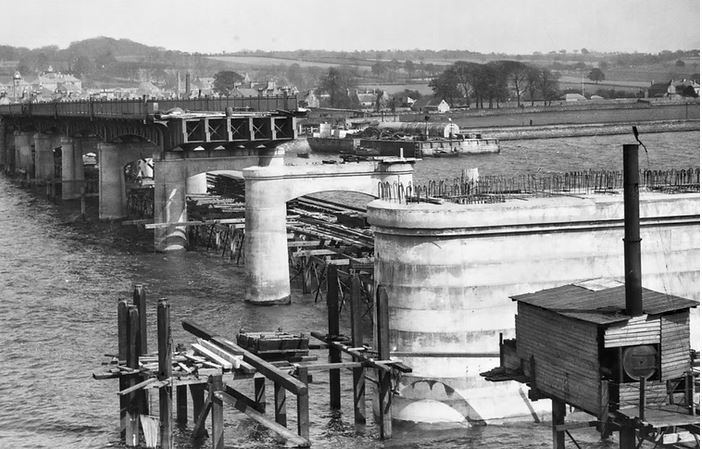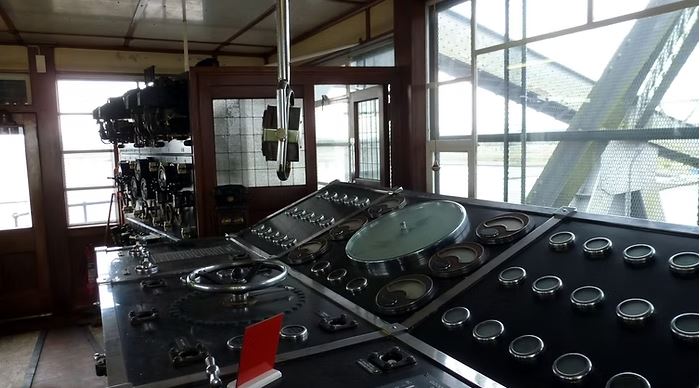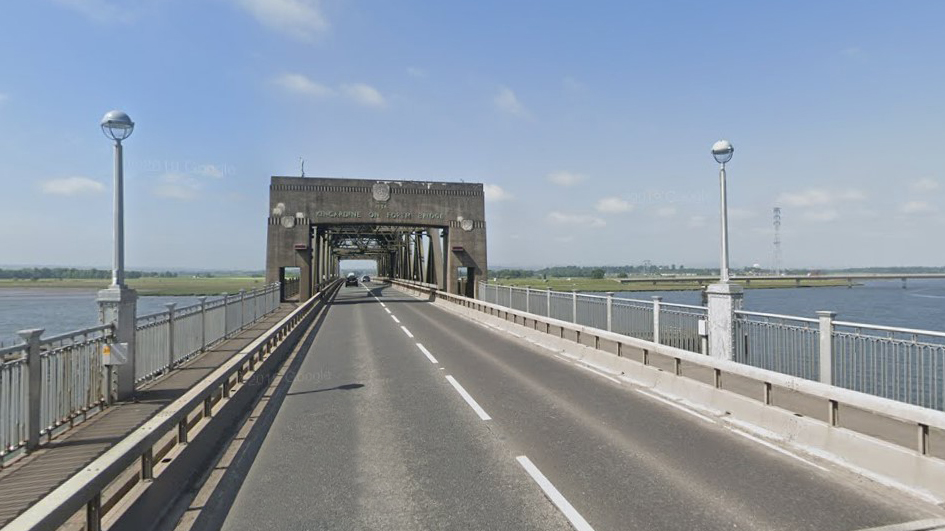Kincardine Bridge - Scotland’s Historic Engineering Marvel And Its Legacy
This important historic bridge, built in a grand style, has special features. You'll notice its impressive curved section that swings open, and its design shows a lot of Art Deco style. When it opened in 1936, it was the longest road bridge in Scotland. It also had the biggest part that could swing open anywhere in Europe.
Author:Callum FraserJul 03, 20256.6K Shares92.2K Views

The Kincardine Bridgeis a road crossing over the River Forth, located 8 miles southeast of Stirling. It was finished in October 1936 and remains an important part of the main road system. It is also a great example of Scottish engineering.
The idea for a new bridge was first talked about in the 1920s because more people needed to cross the river. Sir Alexander Gibb & Partners were hired in 1930 to design the bridge, which for a time was Scotland’s longest road bridge.
When it opened, it reduced traffic jams in Stirling and improved road connections across the country. Until 1988, the bridge worked as a swing bridge. Today, this Category A-listed bridge carries over 10,000 vehicles daily and connects the M876 motorway with the A985 main road.
Location And Basic Information
The bridge crosses the River Forthabout 8 miles southeast of Stirling and 25 miles northwest of Edinburgh. It carries the A985 road (formerly the A876) with one lane in each direction and is 2,696 feet (822 meters) long. The structure is located at coordinates 56°3′54.5″N 3°43′38.2″W and connects several council areas across the Forth, making it a key part of the central Scottish road network.
Planning And Design
Talks about building a road bridge over the River Forth began in the 1920s. Traffic using Stirling Bridge on the A9 was growing quickly, causing heavy traffic in the city. Options for crossing the river were limited, with only a few ferry services at Queensferry, Kincardine, and Alloa.
If these ferries were not running, drivers had to take a 50-mile detour. In 1925, a report was sent to the Ministry of Transport(responsible for roads in Scotland until April 1956) looking at the possibility of a new road bridge at Alloa or Kincardine. Although Kincardine seemed better, concerns about the ground conditions led to Alloa being chosen as the preferred site.
Engineering consultant Mott, Hay & Anderson was hired to prepare plans, but progress was slow due to money problems. In 1930, Fife County Council asked Sir Alexander Gibb & Partners to create a feasibility report for a bridge at Kincardine. Information from boreholes drilled in 1890 for a proposed rail tunnel showed that the ground could support a new bridge.
In June 1930, a meeting was held with representatives from the Ministry of Transport, Fife and Clackmannan Counties, and the towns of Dunfermline, Falkirk, Alloa, and Stirling. They agreed to prepare a joint report on both locations. The report, submitted in August, showed that the Kincardine option was better and cheaper to build. A Joint Board was formed soon after to oversee the bridge’s construction.
Construction Of Kincardine Bridge
Construction of the bridge started in December 1933 and was completed in less than three years, opening on 29th October 1936. At its busiest, over 200 men worked on the site without any major accidents. Early work involved putting in piles for the bridge supports and building temporary wooden access bridges from each side. These had tracks to help move materials and equipment, including cranes.
The reinforced concrete piers on the north side were built using caissons placed on solid rock. Excavated material was loaded into wagons and removed via the wooden bridges. A 150-foot-wide opening in the river was kept clear for ships throughout the work. Some piers were tricky to build because water kept getting into the cylinders, so a system using compressed air was used.
The permanent wooden jetty was finished by autumn 1935. Made from high-quality Canadian Douglas Fir treated with creosote, it was designed to protect the structure when the bridge was open. Over 4,000 tonnes of steel and 150,000 rivets were used to build the bridge.
Steelwork was supplied by Sir William Arrol and Co of Glasgow and brought to the site by rail. Some girders were so long they had to be delivered in smaller sections and bolted together. Cranes on the temporary bridges helped put the steelwork in place. The swing span was finished in mid-1936 and was an impressive example of structural and mechanical engineering.
It was built in the open position to keep shipping channels clear and was finished to a very high standard. A trial setup was done at the fabrication yard before it was moved to the site. The minimum height for vehicles on the bridge is 18 feet, accessed through two concrete portals. These are decorated with the coats of arms of Stirling, Fife, and Clackmannan, and the bridge’s name is written in bronze letters. Each portal has a gate weighing almost 4 tonnes, lowered to keep traffic off the swing span when it opened.
Kincardine Bridge Control Room
The Kincardine Bridge control room was positioned about 30 feet above the carriageway, centrally located in the superstructure of the swing span. It was designed for 24-hour operation and included mess and welfare facilities for the bridge staff who operated the bridge openings.
The control room featured large windows on all sides, providing operators with an uninterrupted view of the entire bridge.This control room housed the original GEC electrical switchgear that automatically controlled the opening procedure of the swing bridge.
The opening sequence began with sirens, traffic lights changing from green to red, and the descent of safety gates to stop all road traffic before the central span was freed to rotate on its rollers. The control room remains beautifully preserved with its original fittings and open switchboards and is now maintained by the Bo'ness Heritage Trust.
Below the control room, in the base of the central pier, was the engine room containing a Tangye 25-horsepower hydraulic pump that activated the mechanical components to retract wedges and locking bolts, allowing the swing span to rest on rollers and rotate. Although the bridge has been fixed in position since 1988 and no longer swings open, the control and engine rooms are preserved as part of the bridge's heritage.
Unique Engineering Features
Swing Bridge Mechanism
One of the most amazing parts of the Kincardine Bridge was its central swing span, which was 364 feet long. When it was built, it was the longest swing bridge in Europe, designed to let ships pass through to reach the Port of Alloa upstream. The swing section weighed about 1,500 tonnes and was supported by 60 steel rollers on a circular track.
The bridge’s swing mechanism was controlled from a well-maintained control room hanging above the road level, featuring original GEC electrical switchgear. Power for the swing came from an engine room in the central pier, supplied by electricity from the Fife side through an underwater cable. Opening the bridge took at least 13 minutes and was done automatically, starting with sirens and traffic lights to stop all road traffic.
Final Opening
By the 1980s, the bridge’s moving parts were old and needed updating. A drop in river traffic, along with the high cost of repairs, led the Scottish Office to suggest permanently closing the swing span. Despite protests from locals and former bridge workers, the plan was approved in 1987 after a public inquiry.
On Sunday, 31st January 1988, the bridge swung open for the last time. Hundreds of people gathered for the event, including transport photographer Donald Stirling, who shared pictures of it. Work to fix the bridge in place was finished by the end of 1989, and the control and engine rooms were kept as a museum.
The Bridge Today
The Kincardine Bridge is now managed by Transport Scotland on behalf of the Scottish Ministers. Over 10,000 vehicles still use the bridge every day. In 2008, it was joined by the Clackmannanshire Bridge upstream, designed to improve traffic flow in the area and bypass Kincardine town center.
In February 2005, Historic Environment Scotland listed the bridge as a Category A structure, recognizing its special architectural and technical features. The bridge is a key part of the Scottish road system, and several multi-million-pound projects are planned to keep it open for decades to come.
The bridge deck was repaired, and new streetlights were installed in the late 2010s. A program to repaint the steelwork and replace the piled south approach viaduct will start in 2022.
Strategic Importance
For nearly 30 years, the Kincardine Bridge was the first road crossing of the River Forth downstream of Stirling, opening almost 30 years before the Forth Road Bridge in 1964. Today, it carries over 10,000 vehicles daily and serves as a vital link connecting the M876 motorway with the A985 main road.
Until the Clackmannanshire Bridge opened in 2008, the Kincardine Bridge was the usual detour route for traffic from Edinburgh and eastern Scotland when the Forth Road Bridge was closed or under repair. This often caused traffic jams in Kincardine because of the extra vehicles joining regular commuter traffic.
Recent Maintenance And Upgrades
Major Refurbishment Program
Transport Scotland has done significant work to maintain this historic structure. Between 2015 and 2019, a £2.3 million program was completed, involving waterproofing and resurfacing 14 sections of the bridge. This included repairing concrete, replacing the bridge deck waterproofing system, installing new expansion joints, and resurfacing the road.
Southern Viaduct Replacement
A major upgrade project began in 2023 to replace the 80-meter southern piled viaduct section, which had been considered substandard since 1984 and supported by a steel propping system since 1992. Transport Scotland gave the £16 million contract to Balfour Beatty, and construction is expected to take about two years. The project involves demolishing the old viaduct and replacing it with a new reinforced concrete structure while keeping traffic moving using a temporary bridge.
Legacy And Significance
The Kincardine Bridge is an outstanding achievement in Scottish civil engineering and a tribute to the skill and creativity of the 1930s. Its unique swing bridge design, impressive length for its time, and continued importance in Scotland’s road network make it a valuable piece of infrastructure history.
The bridge’s Category A listing ensures it is preserved as a key example of early 20th-century bridge engineering. As it nears its ninth decade of service, ongoing maintenance and targeted upgrades will ensure this historic crossing continues to meet Scotland’s transportation needs while preserving its architectural and engineering heritage for future generations.
Frequently Asked Questions
Why Was The Kincardine Bridge Originally Designed With A Swing Span?
The swing span was included to allow larger ships to pass upstream to the port of Alloa, facilitating river traffic beyond the bridge. This feature was essential for maintaining navigation on the River Forth until the port's closure in the late 1980s.
What Impact Did The Kincardine Bridge Have On Local Traffic And Economy When It Opened?
The bridge significantly reduced congestion at Stirling Bridge and improved road communications across central Scotland, boosting trade and travelefficiency between Fife and the Falkirk area.
How Has The Role Of The Kincardine Bridge Changed Since The Opening Of The Clackmannanshire Bridge?
Since the Clackmannanshire Bridge opened in 2008, much of the heavy traffic and diversionary role previously handled by Kincardine Bridge has shifted, reducing congestion in the town of Kincardine and altering traffic patterns.
What Are The Challenges Involved In Maintaining A Historic Bridge Like The Kincardine Bridge?
Maintaining the bridge involves addressing aging structural elements, such as the southern viaduct which required replacement due to substandard condition, while preserving its historic features and ensuring safety for modern traffic volumes.
Are There Any Visitor Attractions Or Activities Related To The Kincardine Bridge Area?
Yes, the nearby town of Kincardine offers attractions including its historic river port character, scenic drives along the Fife Coastal Route, and connections to local heritage such as the birthplace of Sir James Dewar, inventor of the vacuum flask.
Is The Swing Mechanism Of The Kincardine Bridge Still Operational?
No, the swing mechanism was permanently closed in 1988 after the port of Alloa ceased operations for large ships. The bridge now functions as a fixed crossing.
Conclusion
The Kincardine Bridge stands as a remarkable example of early 20th-century Scottish engineering, combining functional design with innovative features such as its once-operational swing span. Serving as the first road crossing of the Firth of Forth downstream of Stirling, it played a pivotal role in improving regional connectivity and supporting economic growth.
While its swing function has ceased, the bridge continues to be a vital transport link and a cherished historic landmark. Ongoing maintenance and sensitive upgrades ensure that the Kincardine Bridge remains both a functional piece of infrastructure and a preserved monument to Scotland’s engineering heritage.

Callum Fraser
Author
Callum Fraser isn't just a writer about Scotland; he's a product of its rugged landscape and rich history. Born and raised in Perthshire, with the Highlands as his backyard, his love for the nation's stories was kindled by local storytellers and long walks through ancient glens.
This passion led him to pursue a degree in Scottish History from the University of Edinburgh. For over 15 years, Callum has dedicated himself to exploring and documenting his homeland, fusing his academic knowledge with essential, on-the-ground experience gained from charting road trips through the Cairngorms, hiking the misty Cuillins of Skye, and uncovering the secrets of traditional recipes in his family's kitchen.
As the Editor-in-Chief and Lead Author for Scotland's Enchanting Kingdom, Callum's mission is simple: to be your most trusted guide. He combines meticulous research with a storyteller's heart to help you discover the authentic magic of Scotland — from its best-kept travel secrets to its most cherished traditional recipes.
Latest Articles
Popular Articles



